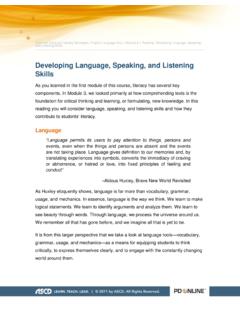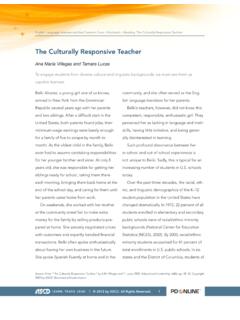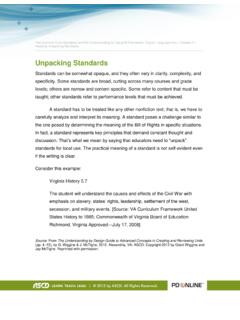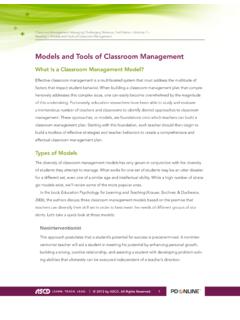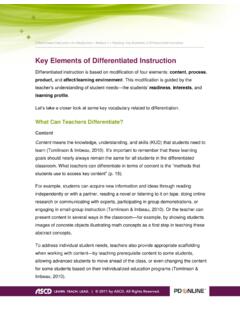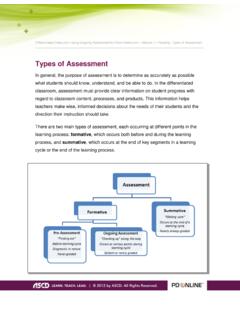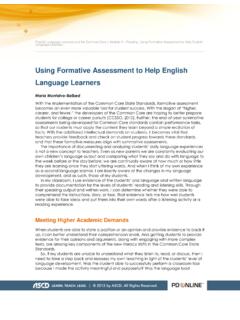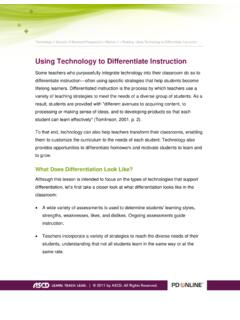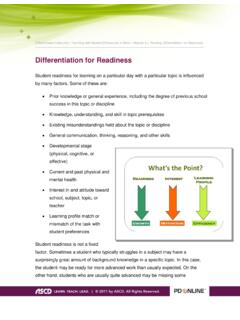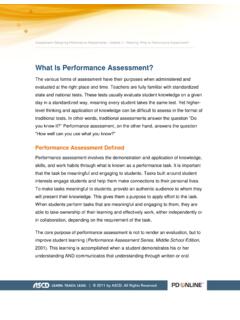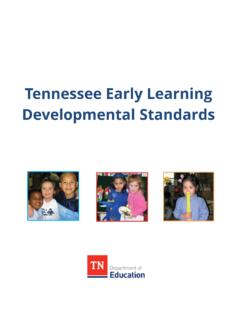Transcription of Developing Language, Speaking, and Listening Skills
1 Common Core and Literacy Strategies: English Language Arts > Module 4 > Reading: Developing Language, Speaking, and Listening Skills _____ Developing Language, Speaking, and Listening Skills As you learned in the first module of this course, literacy has several key components. In Module 3, we looked primarily at how comprehending texts is the foundation for critical thinking and learning, or formulating, new knowledge. In this reading you will consider language, speaking, and Listening Skills and how they contribute to students literacy. Language Language permits its users to pay attention to things, persons and events, even when the things and persons are absent and the events are not taking place. Language gives definition to our memories and, by translating experiences into symbols, converts the immediacy of craving or abhorrence, or hatred or love, into fixed principles of feeling and conduct Aldous Huxley, Brave New World Revisited As Huxley eloquently shows, language is far more than vocabulary, grammar, usage, and mechanics.
2 In essence, language is the way we think. We learn to make logical statements. We learn to identify arguments and analyze them. We learn to see beauty through words . Through language, we process the universe around us. We remember all that has gone before, and we imagine all that is yet to be. It is from this larger perspective that we take a look at language tools vocabulary, grammar, usage, and mechanics as a means for equipping students to think critically, to express themselves clearly, and to engage with the constantly changing world around them. Common Core and Literacy Strategies: English Language Arts > Module 4 > Reading: Developing Language, Speaking, and Listening Skills _____ Common Core State Standards: Language According to the Common Core State Standards (CCSS), mastery of language includes three elements: An understanding of the conventions of standard English: o standard grammar and usage in reading and speaking o standard usage of capitalization, punctuation, and spelling The knowledge of language: o the way language works in varying contexts o language choices that affect style and meaning The acquisition and use of vocabulary.
3 O the use of context clues, word parts, or references to determine what unknown or multiple - meaning words mean o figurative language, relationships between words , and nuance o academic words and phrases, including the knowledge to find the meaning independently The CCSS provide standards that break down the three elements so that, throughout the K 12 years, students develop increased proficiency in language Skills and thereby improve their ability to express themselves through language. According to the CCSS Initiative document (2010), The inclusion of Language standards in their own strand should not be taken as an indication that Skills related to conventions, effective language use, and vocabulary are unimportant to reading, writing, speaking, and Listening ; indeed, they are inseparable from such contexts (p. 25). Developing Vocabulary Vocabulary development has always been an important educational goal. But the CCSS views vocabulary a little bit differently.
4 First, the CCSS considers three tiers of vocabulary: Tier 1: Basic vocabulary and words commonly used by students Common Core and Literacy Strategies: English Language Arts > Module 4 > Reading: Developing Language, Speaking, and Listening Skills _____ Tier 2: High frequency and multiple - meaning words Tier 3: Domain or context -specific words The Common Core State Standards recognize the importance of all three tiers, but put special emphasis on Tier 2 words because they are powerfully useful and they often contain nuance and insight into an author s purpose and meaning . According to the Common Core State Standards Initiative (CCSSI) web page Key Points in English Language Arts, the standards expect that students will grow their vocabulary through a mix of conversations, direct instruction, and reading. The standards will help students determine word meanings , appreciate nuances of words , and steadily expand their repertoire of words and phrases (CCSSI, 2010, Language section, para.)
5 1). Strategies for Language in English Language Arts The emphasis of the CCSS is always to begin with a text. You will want to keep this in mind as you consider how to develop students language Skills . Here are several strategies that might help you address language standards in your classroom. Word Choice Vocabulary should be taught within the context of a text. Instead of telling students what a word means, the teacher invites students to identify and consider the definitions of unknown words . For example: What do you think this word means? What is a synonym or antonym for this word? How do you know? Use the rest of the text to support your understanding of the word. Common Core and Literacy Strategies: English Language Arts > Module 4 > Reading: Developing Language, Speaking, and Listening Skills _____ Taking Instruction a Step Further But teachers should take the discussion a step further for some of the more important Tier 2 words by asking students why the author chose to use the word he or she did.
6 For example, if the words large and bulky are synonyms, why didn t the author just use the word large? Discuss what is unique about the word bulky. What does the word connote? What nuances are there? Do students appreciate the shades of meaning that distinguish similar words from one another? As you can see, this kind of discussion is not easily separated from the meaning of a text. Figurative Language Another language skill that contributes to deep comprehension of a text is the understanding of figurative language. For example: What does a metaphor/simile/image provide that straightforward language does not? How does the figurative language affect the meaning ? Taking Instruction a Step Further Not only do students need to know what specific figurative language means, but they also need to consider why an author would choose to use figurative language rather than stating something outright. Teachers can help students meet the CCSS by asking probing questions, such as, What does this expression tell you about the author?
7 What does it suggest about the author s purpose? Speaking and Listening Terry Roberts and Laura Billings state the importance of speaking and Listening in an article in Educational Leadership (2008): Both speaking and Listening are forms of thinking because they allow a nascent thought to be refined through conversation. The better a student s verbal communication Skills the more quickly his or her thoughts about a complex topic gain clarity and coherence (p. 3). In other words , we Common Core and Literacy Strategies: English Language Arts > Module 4 > Reading: Developing Language, Speaking, and Listening Skills _____ learn to think when we listen and when we speak. According to the CCSSI web page Key Points in English Language Arts, the CCSS expect that students gain, evaluate, and present increasingly complex information, ideas, and evidence through Listening and speaking as well as through media (CCSSI, 2010, Listening and Speaking section, para.)
8 1). Common Core State Standards: Speaking and Listening According to the CCSS, speaking and Listening includes two main elements: The ability to comprehend and collaborate with others: o participation in discussions and projects o evaluation of a variety of information from various sources, including media o evaluation of what a speaker says Skills in the presentation of knowledge and ideas: o audience-appropriate and logical presentation of information o use of media support o adaptation of speech to context and task The Common Core State Standards emphasize the importance of engaging students in academic discussions in a variety of forms and settings whole-class, small-group, and one-on-one. According to the CCSSI web page Key Points in English Language Arts, some of these discussions are formal presentations, but many are the more informal discussions that reflect real life, where students collaborate to answer questions, build understanding, and solve problems (CCSSI, 2010, Speaking and Listening section, para.
9 2). Common Core and Literacy Strategies: English Language Arts > Module 4 > Reading: Developing Language, Speaking, and Listening Skills _____ The following chart shows the progression from elementary to middle grades for this comprehension and collaboration standard for Listening and speaking: 1. Engage effectively in a range of collaborative discussions with diverse partners on grade level topics and texts, building on others ideas and expressing their own clearly. Grade 4 Grade 7 a. Come to discussions prepared, having read or studied required material; explicitly draw on that preparation and other information known about the topic to explore ideas under discussion. b. Follow agreed-upon rules for discussions and carry out assigned roles. c. Pose and respond to specific questions to clarify or follow up on information, and make comments that contribute to the discussion and link to the remarks of others.
10 D. Review the key ideas expressed and explain their own ideas and understanding in light of the discussion. a. Come to discussions prepared, having read or researched material under study; explicitly draw on that preparation by referring to evidence on the topic, text or issue to probe and reflect on ideas under discussion. b. Follow rules for collegial discussions, track progress toward specific goals and deadlines, and define individual roles as needed. c. Pose questions that elicit elaboration and respond to other s questions and comments with relevant observations and ideas that bring the discussion back on topic as needed. d. Acknowledge new information expressed by others and, when warranted, modify their views. Strategies for Speaking and Listening in English Language Arts Collaboration is one of the most important aspects of the Common Core speaking and Listening standards, in large part because it reflects how things happen in the real world.
